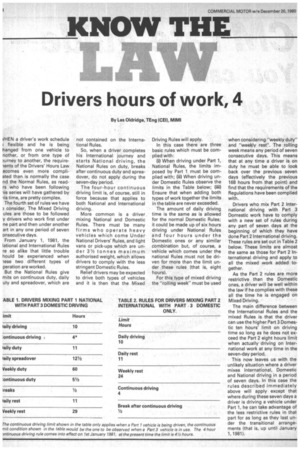Drivers hours of work, 4
Page 36

If you've noticed an error in this article please click here to report it so we can fix it.
By Les Oldridge, TEng (CEO, MIMI VHEN a driver's work schedule
flexible and he is being hanged from one vehicle to nother, or from one type of )urney to another, the require-lents of the Drivers' Hours Law ecomes even more compliated than is normally the case nd the Normal Rules, as readrs who have been following us series will have gathered by us time, are pretty complex. The fourth set of rules we have ) consider, The Mixed Driving ules are those to be followed y drivers who work first under ne part and then under another art in any one period of seven onsecutive days.
From January 1, 1981, the lational and International Rules re so alike that little trouble hould be experienced when lese two different types of peration are worked.
But the National Rules give mits on continuous duty, daily uty and spreadover, which are not contained on the International Rules.
So, when a driver completes his International journey and starts National driving, the National Rules on duty, breaks after continuous duty and spreadover, do not apply during the seven-day period.
The four-hour continuous driving limit is, of course, still in force because that applies to both National and International driving.
More common is a driver mixing National and Domestic Rules. There must be many firms who operate heavy vehicles which come Under National Drivers' Rules, and light vans or pick-ups which are under 31/2 tonnes maximum authorised weight, which allows drivers to comply with the less stringent Domestic Rules.
Relief drivers may be expected to drive both types of vehicles and it is then that the Mixed Driving Rules will apply.
In this case there are three basic rules which must be complied with: (i) When driving under Part 1, National Rules, the limits imposed by Part 1. must be complied with; (ii) When driving under Domestic Rules observe the limits in the Table below; (iii) Ensure that when adding both types of work together the limits in the table are never exceeded.
The amount of daily driving time is the same as is allowed for the normal Domestic Rules; it could be made up of six hours driving under National Rules and four hours under the Domestic ones or any similar combination but, of course, a vehicle which comes under the national Rules must not be driven for more than the limit under these rules (that is, eight hours).
For this type of mixed driving the "rolling week" must be used when considering "weekly duty" and "weekly rest". The rolling week means any period of seven consecutive days. This means that at any time a driver is on duty he must be able to look back over the previous seven days (effectively the previous 168 hours from that point) and find that the requirements of the Regulations have been complied with.
Drivers who mix Part 2 International driving with Part 3 Domestic work have to comply with a new set of rules during any part of seven days at the beginning of which they have done Part 2 International driving. These rules are set out in Table 2 below. These limits are almost the same as those for Part 2 International driving and apply to all the mixed work added together.
As the Part 2 rules are more restrictive than the Domestic ones, a driver will be well within the law if he complies with these all the time he is engaged on Mixed Driving.
The main difference between the International Rules and the mixed Rules is that the driver can use the higher Part 3 Domestic ten hours' limit on driving time so long as he does not exceed the Part 2 eight hours limit when actually driving on International work at any time in the seven-day period.
This now leaves us with the unlikely situation where a driver mixes International, Domestic and National driving in a period of seven days. In this case the rules described immediately above will apply except that where during these seven days a driver is driving a vehicle under Part 1, he can take advantage of the less restrictive rules in that part for as long as they last under the transitional arrangements (that is, up until January 1,1981).




















































































